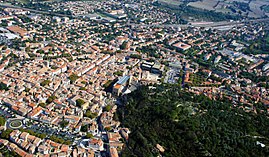Orange, France
| Orange | ||
|---|---|---|

Aerial view of downtown Orange
|
||
|
||
| Coordinates: 44°08′18″N 4°48′35″E / 44.1383°N 4.8097°ECoordinates: 44°08′18″N 4°48′35″E / 44.1383°N 4.8097°E | ||
| Country | France | |
| Region | Provence-Alpes-Côte d'Azur | |
| Department | Vaucluse | |
| Arrondissement | Avignon | |
| Canton | Orange | |
| Government | ||
| • Mayor (2008–2014) | Jacques Bompard | |
| Area1 | 74.2 km2 (28.6 sq mi) | |
| Population (2007)2 | 30,025 | |
| • Density | 400/km2 (1,000/sq mi) | |
| Time zone | CET (UTC+1) | |
| • Summer (DST) | CEST (UTC+2) | |
| INSEE/Postal code | 84087 /84100 | |
| Elevation | 24–127 m (79–417 ft) (avg. 50 m or 160 ft) |
|
|
1 French Land Register data, which excludes lakes, ponds, glaciers > 1 km² (0.386 sq mi or 247 acres) and river estuaries. 2Population without double counting: residents of multiple communes (e.g., students and military personnel) only counted once. |
||
| Roman Theatre and its surroundings and the Triumphal Arch of Orange | |
|---|---|
| Name as inscribed on the World Heritage List | |
| Location | France |
| Type | Cultural |
| Criteria | iii, vi |
| Reference | 163 |
| UNESCO region | Europe and North America |
| Inscription history | |
| Inscription | 1981 (5th Session) |
1 French Land Register data, which excludes lakes, ponds, glaciers > 1 km² (0.386 sq mi or 247 acres) and river estuaries.
Orange (Provençal Occitan: Aurenja in classical norm or Aurenjo in Mistralian norm) is a commune in the Vaucluse Department in the Provence-Alpes-Côte d'Azur region in southeastern France, about 21 km (13 mi) north of Avignon. It has a primarily agricultural economy.
Roman Orange was founded in 35 BC by veterans of the second legion as Arausio (after the local Celtic water god), or Colonia Julia Firma Secundanorum Arausio in full, "the Julian colony of Arausio established by the soldiers of the second legion." The name was originally unrelated to that of the orange fruit, but was later conflated with it (see Orange (word)).
A previous Celtic settlement with that name existed in the same place, and a major battle, which is generally known as the Battle of Arausio, had been fought in 105 BC between two Roman armies and the Cimbri and Teutones tribes.
Arausio covered an area of some 170 acres (69 ha) and was well endowed with civic monuments; in addition to the theatre and arch, it had a monumental temple complex and a forum.
Orange in the Table Peutinger
Roman Cadaster of Orange
It was the capital of a wide area of northern Provence, which was parcelled up into lots for the Roman colonists. "Orange of two thousand years ago was a miniature Rome, complete with many of the public buildings that would have been familiar to a citizen of the Roman Empire, except that the scale of the buildings had been reduced – a smaller theater to accommodate a smaller population, for example." It is found in both the Tabula Peutingeriana and Le cadastre d'Orange maps.
...
Wikipedia



